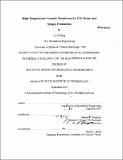| dc.contributor.advisor | Ahmed F. Ghoniem. | en_US |
| dc.contributor.author | Chang, Le, S.M. Massachusetts Institute of Technology | en_US |
| dc.contributor.other | Massachusetts Institute of Technology. Department of Mechanical Engineering. | en_US |
| dc.date.accessioned | 2014-03-06T15:46:51Z | |
| dc.date.available | 2014-03-06T15:46:51Z | |
| dc.date.copyright | 2013 | en_US |
| dc.date.issued | 2013 | en_US |
| dc.identifier.uri | http://hdl.handle.net/1721.1/85505 | |
| dc.description | Thesis: S.M., Massachusetts Institute of Technology, Department of Mechanical Engineering, 2013. | en_US |
| dc.description | Cataloged from PDF version of thesis. | en_US |
| dc.description | Includes bibliographical references (pages 140-146). | en_US |
| dc.description.abstract | In recent years, membrane based technologies have attracted much attention thanks to their simplicity in reactor design. The concept proposed is to use mixed ionic-electronic conducting membrane (MIEC) in CO2 reuse and syngas production by taking the advantage of low quality energy resource. The membrane under investigation is a La0,9Cao01FeO3 -6 (LCF) perovskite membrane. Membranes with perovskite structure have shown high oxygen permeability and 100% oxygen selectivity. These membranes have also been demonstrated to produce H2 by water splitting. During the reaction, H2 is produced on the membrane feed side and the resultant oxygen is transported to the membrane sweep side, thus shifting the water splitting reaction towards hydrogen production. Under the same principle, CO is also likely to be produced from CO2 dissociation in the membrane reactor. The produced H2 can be further processed with CO2 to yield hydrocarbon fuel. In this way, the usual products of combustion, H20 and CO2, can be reused by the membrane reactor. In this thesis, a literature review of the existing technologies of hydrogen production and CO2 reduction is presented. The reviewed technologies are compared to our proposed method for water splitting and CO2 reuse. A bench scale reactor was built to test the LCF membrane in order to understand the characteristics of the membrane. Tests are also done for the proposed water splitting reaction. The reactor design, experimental set-ups and experimental procedures are also presented in this thesis. The results of the experiments are analyzed and future work for improving the membrane reactor is proposed. | en_US |
| dc.description.statementofresponsibility | by Le Chang. | en_US |
| dc.format.extent | 146 pages | en_US |
| dc.language.iso | eng | en_US |
| dc.publisher | Massachusetts Institute of Technology | en_US |
| dc.rights | M.I.T. theses are protected by copyright. They may be viewed from this source for any purpose, but reproduction or distribution in any format is prohibited without written permission. See provided URL for inquiries about permission. | en_US |
| dc.rights.uri | http://dspace.mit.edu/handle/1721.1/7582 | en_US |
| dc.subject | Mechanical Engineering. | en_US |
| dc.title | High temperature ceramic membrane for CO₂ reuse and syngas production | en_US |
| dc.type | Thesis | en_US |
| dc.description.degree | S.M. | en_US |
| dc.contributor.department | Massachusetts Institute of Technology. Department of Mechanical Engineering | |
| dc.identifier.oclc | 871003926 | en_US |
